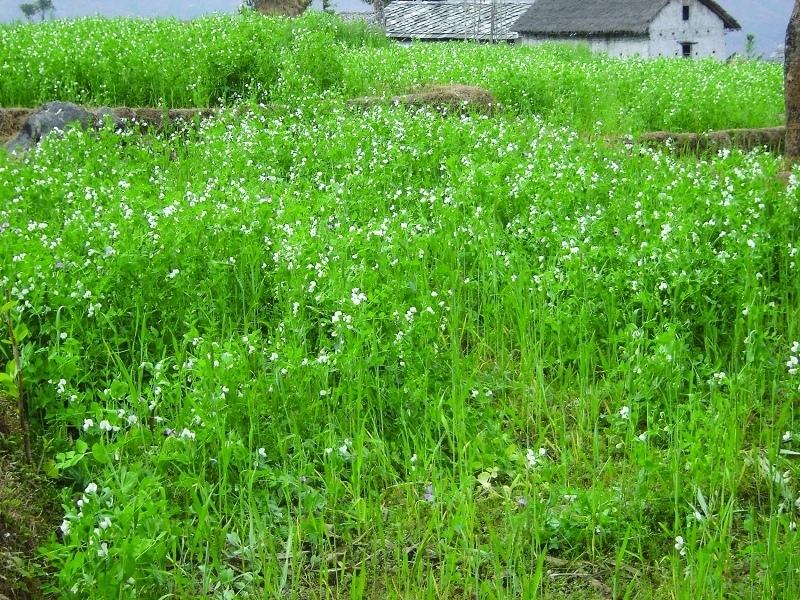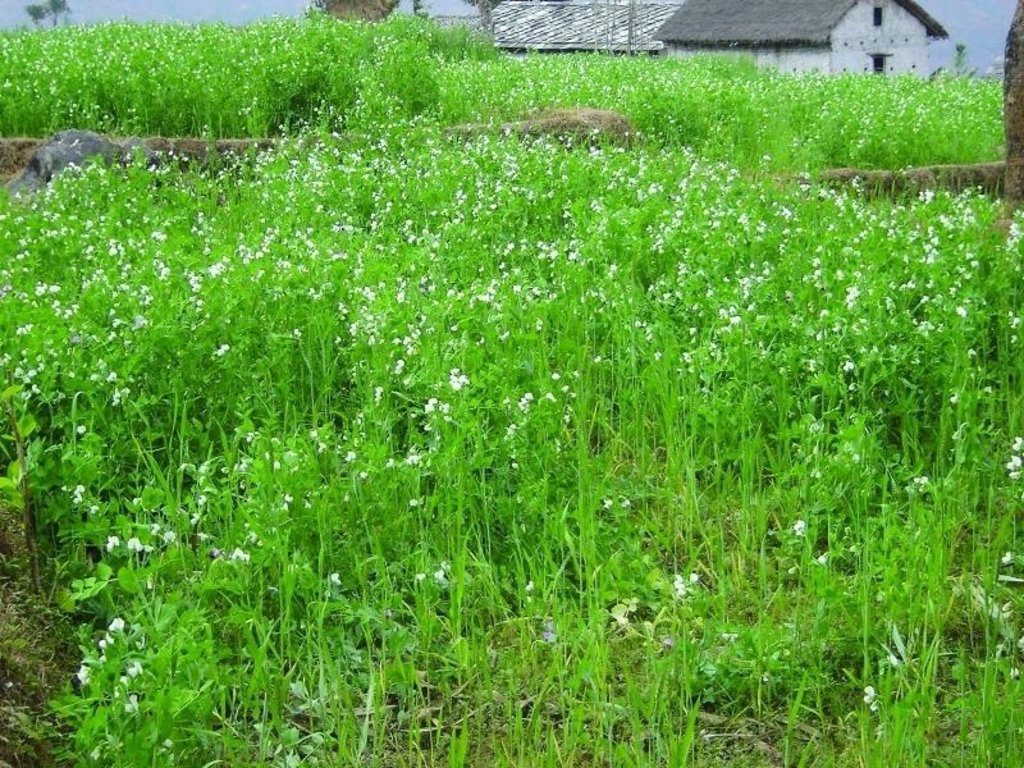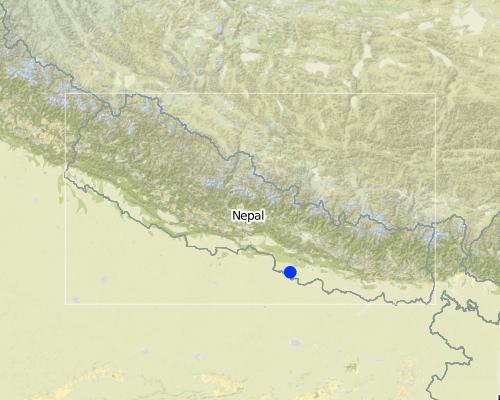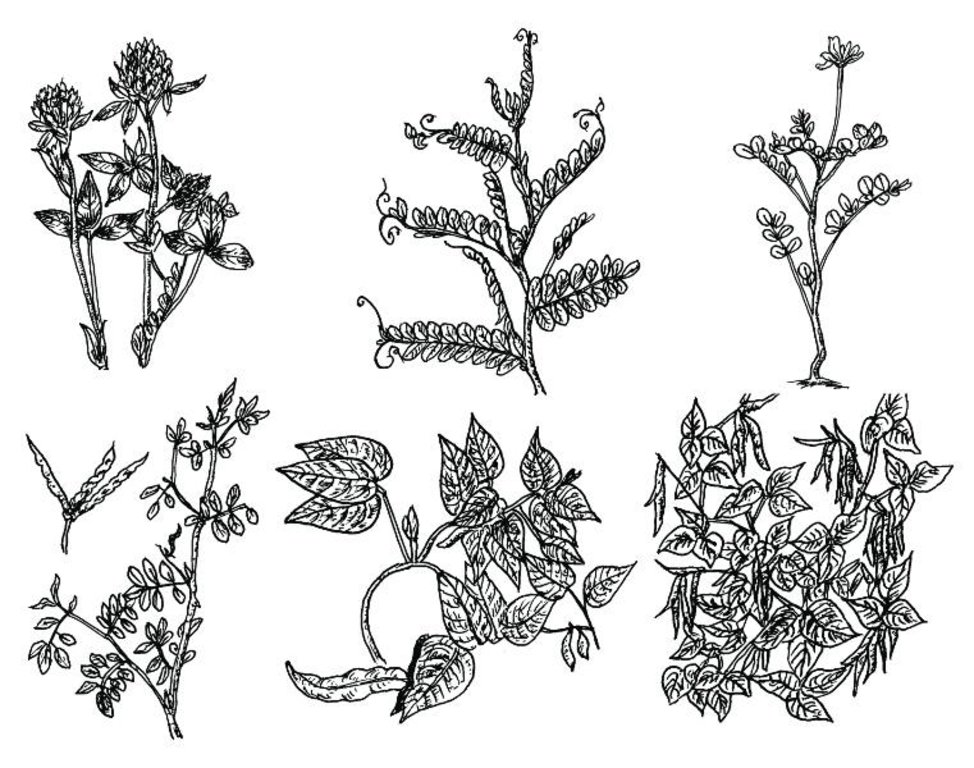Legume integration [النيبال]
- تاريخ الإنشاء:
- تحديث:
- جامع المعلومات: Richard Allen
- المحرر: –
- المُراجع: David Streiff
Bali pranali ma kosebali samabesh
technologies_1753 - النيبال
عرض الأقسام
توسيع الكل طي الكل1. معلومات عامة
1.2 تفاصيل الاتصال بالأشخاص الرئيسيين لمصدر المعلومات والمؤسسات المشاركة في تقييم وتوثيق التقنية
متخصص في الإدارة المستدامة للأراضي:
Director
+977 1 5520314
Soil Management Directorate, Department of Agriculture
النيبال
متخصص في الإدارة المستدامة للأراضي:
Team Leader
+977 1 5543591
Sustainable Soil Management Programme
النيبال
اسم المشروع الذي سهّل توثيق/تقييم التقنية (إذا كان ذلك على صلة)
Sustainable Soil Management Programme, Nepal (SSMP)اسم المؤسسة (المؤسسات) التي سهلت توثيق/تقييم التقنية (إذا كان ذلك على صلة)
Department of Agriculture, Soil Management Directorate, Hariharbhawan Lalitpur (doasoil) - النيبالاسم المؤسسة (المؤسسات) التي سهلت توثيق/تقييم التقنية (إذا كان ذلك على صلة)
HELVETAS (Swiss Intercooperation)1.3 الشروط المتعلقة باستخدام البيانات الموثقة من خلال WOCAT
متى تم تجميع البيانات (ميدانيا)؟:
11/05/2008
يوافق جامع المعلومات والشخص (لاشخاص) الرئيسي لمصدر المعلومات على الشروط المتعلقة باستخدام البيانات الموثقة من خلال WOCAT:
نعم
1.5 الإشارة إلى الاستبيان (الاستبيانات) حول مناهج الإدارة المستدامة للأراضي

Farmer field schools on integrated plant nutrient systems [النيبال]
Participatory and collaborative learning through the farmer field school approach
- جامع المعلومات: Richard Allen
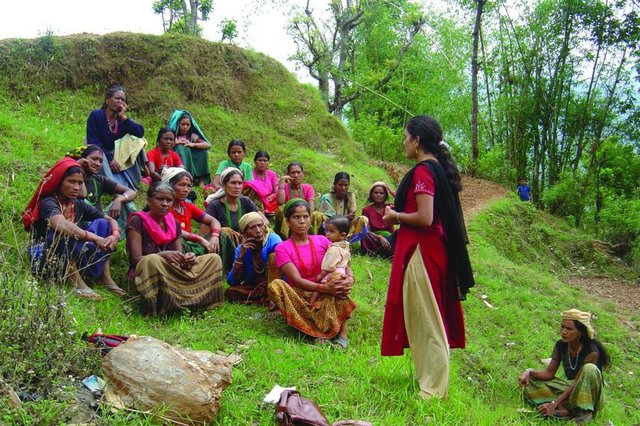
Farmer-led experimentation [النيبال]
Participatory technology testing and adaptation through farmer-led experiments
- جامع المعلومات: Richard Allen

Farmer-to-farmer diffusion [النيبال]
Wider diffusion of sustainable soil management technologies through a demand responsive farmer-to-farmer diffusion approach
- جامع المعلومات: Richard Allen
2. وصف تقنيةالإدارة المستدامي للأراضي
2.1 وصف مختصر للتقنية
تعريف التقنية:
Integration of leguminous crops as intercrops on terrace risers or as relay crops
2.2 وصف تفصيلي للتقنية
الوصف:
Legumes are widely grown across the hills of Nepal, with the most common being soybean, lentils, black gram, cow pea, beans, horse gram, field peas, and rice bean. They are mostly intercropped or relay cropped with cereals such as maize, millet, and rice. They are also planted on the edges of terraces and rice paddy bunds. Depending on the species, they may be grown in rain-fed or irrigated fields during the winter or summer seasons.
The majority of the legumes grown by farmers are used for food or as a cash crop. The planting of fodder legumes has become more popular with the expansion of stall-feeding and the development of a dairy industry. The planting of legumes, with the main objective of improving soil fertility is a more recent development in Nepal’s hills.
Nitrogen is the main plant nutrient element and is usually applied through commercial fertiliser where available. Legumes fix atmospheric nitrogen through bacterial nodules on their roots, then nitrogen subsequently becomes available to the following crops. It is important, therefore, not to uproot the legume crop during harvesting - it should be harvested by cutting the above ground parts leaving the roots (and the nodules) in the soil. The crop residues can be fed to livestock, used as animal bedding, applied as green manure directly to fields, or incorporated in compost. In this way most of the nitrogen that was fixed by the legume crop is returned to the soil.
Details about the different legume species and their different characteristics and uses are described in detail in SSMP, PARDYP and SSD-NARC (2000).
2.3 صور التقنية
2.5 البلد/المنطقة/المواقع التي تم تنفيذ التقنية فيها والتي يغطيها هذا التقييم
البلد:
النيبال
مزيد من التفاصيل حول الموقع:
Midhills districts of Nepal
Map
×3. تصنيف تقنية الإدارة المستدامي للأراضي
3.1 الغرض الرئيسي ( الأغراض الرئيسية) للتقنية
- improve soil fertility
3.2 نوع (أنواع) استخدام الأراضي الحالية حيث يتم تطبيق التقنية

الأراضي الزراعية
- زراعة سنوية
التعليقات:
Major land use problems (compiler’s opinion): Intensifying cultivation practices with either 1) inadequate application of fertilisers leading to a decline in soil
fertility and the mining of soil nutrients or 2) the application of too much fertiliser causing environmental problems
through excessive leaching, losses of fertiliser in surface runoff, and consequent eutrophication or nitrification of streams,
ponds, or groundwater.
3.4 مجموعةالإدارة المستدامة للأراضي التي تنتمي إليها هذه التقنية
- الإدارة المتكاملة لخصوبة التربة
- تحسين أصناف النباتات/سلالات الحيوانات
3.5 انتشار التقنية
حدد انتشار التقنية:
- منتشرة بالتساوي على مساحة
3.6 التدابير التقنية في مجال إلادارة المستدامة للأراضي

التدابير الزراعية
- A2: المادة العضوية/خصوبة التربة
3.7 الأنواع الرئيسية من تدهور الأراضي التي تناولتها التقنية

التدهور الكيميائي للتربة
- (Cn): تراجع الخصوبة وانخفاض محتوى المادة العضوية (غير ناتج عن الانجراف)
3.8 منع أو حد أو عكس تدهور الأراضي
تحديد هدف التقنية فيما يتعلق بتدهور الأراضي:
- الحد من تدهور الأراضي
4. المواصفات الفنية، وأنشطة التنفيذ، والمدخلات، والتكاليف
4.1 الرسم الفني للتقنية
4.2 المواصفات الفنية/شروحات الرسم الفني
A number of species are presented
in the legume integration decision
support guide (SSMP, PARDYP, SSDNARC 2000). Here only a selection of useful legume species are presented (from top left corner to lower right corner):
- red clover (Trifolium pratense)
- hairy vetch (Vicia villosa Roth)
- Chinese milk vetch (Astragalus sinicus)
- rice bean (Vigna umbellata)
- velvet bean (Mucuna pruriens)
- tephrosia (Tephrosia spp.
Technical knowledge required for field staff / advisors: low
Technical knowledge required for land users: low
Main technical functions: increase in soil fertility (nitrogen in particular), increase in soil productivity & decrease in soil erosionon terrace bunds, nutritius and high value crops
Secondary technical functions: fodder and green manure availability & income
4.3 معلومات عامة بخصوص حساب المدخلات والتكاليف
حدد كيفية احتساب التكاليف والمدخلات:
- لكل وحدة تقنية
حدد العملة المستخدمة لحساب التكاليف:
- دولار أمريكي
اذكر متوسط تكلفة أجر العمالة المستأجرة في اليوم الواحد:
2.00
4.5 التكاليف والمدخلات اللازمة للتأسيس
| تحديد المدخلات | الوحدة | الكمية | التكاليف لكل وحدة | إجمالي التكاليف لكل مدخل | % من التكاليف التي يتحملها مستخدمو الأراضي | |
|---|---|---|---|---|---|---|
| العمالة | Labour | Persons/day | 2,5 | 2,0 | 5,0 | |
| المواد النباتية | Seeds | unit | 1,0 | 1,5 | 1,5 | |
| إجمالي تكاليف إنشاء التقنية | 6,5 | |||||
4.6 الصيانة/الأنشطة المتكررة
| النشاط | نوع التدبير | التوقيت/الوتيرة | |
|---|---|---|---|
| 1. | Depending on the type of farm niche - broadcast, line sow, or spot | زراعية |
4.7 التكاليف والمدخلات اللازمة للصيانة/للأنشطة المتكررة (سنويًا)
التعليقات:
Cost as in January 2007
5. البيئة الطبيعية والبشرية
5.1 المناخ
هطول الأمطار السنوي
- < 250 مم
- 251- 500 ملم
- 501 - 750ملم
- 1,000-751 ملم
- 1,500-1,100 ملم
- 2,000-1,500 ملم
- 3,000-2,001 ملم
- 4,000-3,100 ملم
- > 4000 ملم
المواصفات/التعليقات على هطول الأمطار:
Annual rainfall: Also 2000-3000 mm
المنطقة المناخية الزراعية
- رطبة
Thermal climate class: subtropics
5.2 طوبوغرافيا
متوسط الانحدارات:
- مسطح (0-2%)
- بسيط (3-5%)
- معتدل (6-10%)
- متدحرج (11-15%)
- تلال (16-30%)
- شديدة الانحدار(31-60%)
- فائقة الانحدار (>60%)
التضاريس:
- هضاب/سهول
- أثلام مرتفعة
- المنحدرات الجبلية
- منحدرات التلال
- منحدرات في السفوح
- قاع الوادي
المنطقة الارتفاعية:
- 100-0 متر فوق سطح البحر
- 500-101 متر فوق سطح البحر
- 1,000-501 متر فوق سطح البحر
- 1,500-1,001 متر فوق سطح البحر
- 2,000-1,501 متر فوق سطح البحر
- 2,500-2,100 متر فوق سطح البحر
- 3,000-2,501 متر فوق سطح البحر
- 4,000-3,001 متر فوق سطح البحر
- > 4000 متر فوق سطح البحر
التعليقات والمواصفات الإضافية بشأن التضاريس:
Slopes on average:Also moderate (6-10%), rolling (11-15%) and hilly (16-30%)
Landforms: Also footslopes
Altitudinal zone: Also 1000-1500 m a.s.l., 1500-2000 m a.s.l. and 2000-2500 m a.s.l.
5.6 خصائص مستخدمي الأراضي الذين يطبقون التقنية
التوجه السوقي لنظام الإنتاج:
- الكفاف (الإمداد الذاتي)
- تجاري/سوق
أفراداً أو مجموعات:
- فرد/أسرة معيشية
اذكر الخصائص الأخرى ذات الصلة لمستخدمي الأراضي:
Off-farm income specification: In most farm households, off-farm income plays at least a minor and increasingly a major role. Occasional opportunities for off-farm income present themselves in the form of daily labour wages. Some households’ members receive regular salaries whilst an increasing number of Nepalis are working in India, the Middle East, Malaysia and elsewhere and sending remittance incomes home.
5.7 متوسط مساحة الأرض المملوكة أو المستأجرة من قبل مستخدمي الأراضي الذين يطبقون التقنية
- < 0.5 هكتارا
- 0.5 - 1 هكتار
- 1 -2 هكتار
- 2 - 5 هكتار
- 5 - 15 هكتار
- 15 - 50 هكتار
- 50 - 100هكتار
- 500-100 هكتار
- 1,000-500 هكتار
- 10,000-1,000 هكتار
- > 10,000 هكتار
5.8 ملكية الأراضي، وحقوق استخدام الأراضي، وحقوق استخدام المياه
ملكية الارض:
- فردية، لا يوجد سند ملكية
- فردية، يوجد سند ملكية
حقوق استخدام الأراضي:
- مؤجر
- فردي
التعليقات:
sharecropping between owner and tenant
6. الآثار والتصريحات الختامية
6.1 الآثار التي أظهرتها التقنية في الموقع
الآثار الاجتماعية والاقتصادية
الدخل والتكاليف
النفقات على المدخلات الزراعية
التعليقات/ حدد:
Reduced expenses for nitrogen fertilizers
آثار اجتماعية واقتصادية أخرى
Livestock fodder nutritiousness
Value and nutritiousness of crops
Crop in terms of main yield
الآثار الايكولوجية
التربة
فقدان التربة
المادة العضوية في التربة/تحت الطبقة c
التنوع البيولوجي: الغطاء النباتي، الحيوانات
مكافحة الآفات/الأمراض
التعليقات/ حدد:
Highly susceptible to diseases and pests
الآثار الايكولوجية الأخرى
Application of fertilizer
6.2 الآثار التي أظهرتها التقنية خارج الموقع
تلوث المياه الجوفية/الأنهار
التعليقات/ حدد:
Reduced nutrient flux into water bodies
Dependence on outside
6.4 تحليل التكلفة والعائد
كيف يمكن مقارنة العوائد نسبة لتكاليف الإنشاء (من وجهة نظر مستخدمي الأراضي)؟
عوائد قصيرة الأجل:
إيجابي
عوائد طويلة الأجل:
إيجابي
كيف تتم مقارنة العوائدمع كلفة الصيانة/التكاليف المتكررة (من وجهة نظر مستخدمي الأراضي)؟
عوائد قصيرة الأجل:
إيجابي
عوائد طويلة الأجل:
إيجابي
التعليقات:
On average a benefi t of US$ 40 to 50 per ropani can be expected from the production of legume species
6.5 اعتماد التقنية
التعليقات:
Comments on spontaneous adoption: About 80% of participating farmers used/had adopted the technolog. It has also been adopted by farmers who have not directly participated in SSMP activities.
6.7 نقاط القوة / المزايا / الفرص التي توفرها التقنية
| نقاط القوة/ المزايا/ الفرص من وجهة نظر جامع المعلومات أو غيره من الاشخاص الرئيسيين لمصدر المعلومات |
|---|
| Cost effective in terms of inputs and management practices in comparison with other commodities |
| Needs less agronomic practices and care (i.e. can be cultivated in zero or reduced tillage) |
| Has multiple uses: food crop, feed crop, fodder, soil building |
| Can be integrated in varying niches on farms and therefore does not need additional land |
| Rich indigenous knowledge exists |
6.8 نقاط ضعف / مساوىء / مخاطر التقنية وسبل التغلب عليها
| نقاط الضعف/ المساوىء/ المخاطر من وجهة نظر جامع المعلومات أو غيره من الاشخاص الرئيسيين لمصدر المعلومات | كيف يمكن التغلب عليها؟ |
|---|---|
| Highly vulnerable to diseases and pests | Skip planting time (i.e. preponing planting of crops to get around life cycle of pests) , use location specifi c species, resistant varieties |
| Very susceptible to waterlogging | Only plant in well-drained soils |
| In high fertility conditions, nitrogen fixing rhizobium does not work leading to less nitrogen fixation | For very specifi c and new species, the soil needs to be inoculated with the correct strain of bacteria |
| Legumes generally do not respond to nitrogen fertiliser | Do not apply nitrogen fertiliser to legumes |
7. المراجع والروابط
7.2 المراجع للمنشورات المتاحة
العنوان، المؤلف، السنة، النظام القياسي الدولي لترقيم الكتب ISBN:
SSMP (2005) Legume Integration Manual (in Nepali). Kathmandu: Sustainable Soil Management Programme
متاح من أين؟كم التكلفة؟:
SSMP
العنوان، المؤلف، السنة، النظام القياسي الدولي لترقيم الكتب ISBN:
SSMP; PARDYP; SSD-NARC (2000) LegumeIntegration into Hill Farming Systems, Decision Support Guide Kathmandu: Sustainable Soil Management Programme, People and Resource Dynamics Project and Soil Science Division-Nepal Agricultural Research Council
متاح من أين؟كم التكلفة؟:
SSMP
الروابط والوحدات المواضيعية
توسيع الكل طي الكلالروابط

Farmer field schools on integrated plant nutrient systems [النيبال]
Participatory and collaborative learning through the farmer field school approach
- جامع المعلومات: Richard Allen

Farmer-led experimentation [النيبال]
Participatory technology testing and adaptation through farmer-led experiments
- جامع المعلومات: Richard Allen

Farmer-to-farmer diffusion [النيبال]
Wider diffusion of sustainable soil management technologies through a demand responsive farmer-to-farmer diffusion approach
- جامع المعلومات: Richard Allen
الوحدات المواضيعية
لا يوجد وحدات مواضيعية


